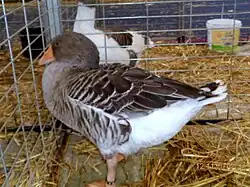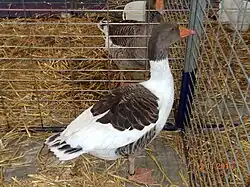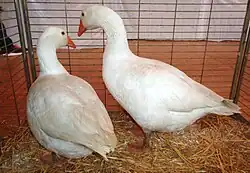Alsace (goose breed)
 The grey | |
 The pied | |
| Conservation status | |
|---|---|
| Other names | |
| Country of origin | German Empire, France |
| Distribution | Alsace |
| Classification | |
| APA | not recognised[4] |
| EE | yes[5] |
| PCGB | not recognised[6] |
| |

The Alsace or Elsässer is a French breed of goose originating in the historical region of Alsace in eastern France, on the border with Germany. It was bred in the nineteenth century to grow a large and fatty liver for foie gras production.
History
The Alsace was bred from about 1880 in the historical region of Alsace in eastern France – which at that time lay within the German Empire – particularly in the small valleys of southern Alsace – those of the Bruche, the Moder, the Sauer and the Zorn – as well as the Ried wetlands of the Rhine Valley.[7]: 18 Local geese were cross-bred with Pomeranian and Emden stock with the specific aim of rearing geese with good aptitude for production of goose liver to be made into the paté de foie gras de Strasbourg, which had originated in Alsace in the previous century.[8]: 39 [9]: 317 Gustave Louis Maurice Strauss, writing in 1887, described it as markedly inferior to the Toulouse, capable of reaching weights when force-fed of little more than half those attainable by the Toulouse.[10]: 103
It was formally recognised as a breed in 1920.[11] By 1960 numbers of the breed had fallen so far that the Union des Aviculteurs du Bas-Rhin took steps to conserve it, establishing centres of breeding.[11] The total number of the geese was estimated in 1994 to be between 1000 and 10000; no population data has since been reported, and in 2025 the conservation status of the breed was unknown.[2]
Characteristics
Four colour varieties are recognised by the Fédération Française des Volailles: the grey, the pied, the white and the grey-spotted (tacheté gris et blanc);[12] the breed society, the Poule et Oie d'Alsace Club de France, recognises the first three of these, but not the last-mentioned.[11] The Entente Européenne recognises only the grey and the pied.[5]
Body weight is some 4 to 4.5 kg for both ganders and geese.[7]: 18 Ring size is 22 mm for both.[13]
Use
The Alsatian was bred specifically for production of foie gras d'oie. Geese may lay some 20 to 35 eggs per year;[14]: 67 they are white and weigh about 120 g.[15][11]
References
- ^ Barbara Rischkowsky, Dafydd Pilling (editors) (2007). List of breeds documented in the Global Databank for Animal Genetic Resources, annex to The State of the World's Animal Genetic Resources for Food and Agriculture. Rome: Commission on Genetic Resources for Food and Agriculture, Food and Agriculture Organization of the United Nations. ISBN 9789251057629. Archived 23 June 2020.
- ^ a b Breed data sheet: Oie d'Alsace / France (Goose (domestic)). Domestic Animal Diversity Information System of the Food and Agriculture Organization of the United Nations. Accessed August 2025.
- ^ Chris Ashton (2012). Keeping Geese. Ramsbury, Marlborough: The Crowood Press. ISBN 9781847973368.
- ^ APA Recognized Breeds and Varieties: As of January 1, 2012. American Poultry Association. Archived 4 November 2017.
- ^ a b Liste des races et variétés homologuée dans les pays EE (28.04.2013). Entente Européenne d’Aviculture et de Cuniculture. Archived 16 June 2013.
- ^ Geese. Poultry Club of Great Britain. Archived 9 November 2018.
- ^ a b Alain Fournier (2005). L'élevage des oies et des canards (in French). Paris: Artémis. ISBN 9782844163486.
- ^ Gabriel Lissot (1946). Oies et canards (in French). Paris: Flammarion.
- ^ Adrien Zeller, Alexandre Lazareff, Alain Weill (1998). Alsace : produits du terroir et recettes traditionnelles (in French). Paris: Albin Michel; Conseil national des arts culinaires. ISBN 9782226106766.
- ^ An Old Bohemian [Gustave Louis Maurice Strauss] (1887). Dr. Strauss's Cookery Book: Dishes and drinks: or, Philosophy in the kitchen. London: Ward & Downey.
- ^ a b c d Historique (in French). Niederbronn-Les-Bains: Poule et Oie d'Alsace Club de France. Archived 16 August 2025.
- ^ Liste des variétés canards, oies, dindons, pintades reconnues en France, Janvier 2025 (in French). Fédération Française des Volailles. Archived 15 August 2025.
- ^ Elsässer Gänse (in German). SV Deutscher Gänsezüchter. Archived 26 March 2016.
- ^ Marie-France Avignon (1981). Oies et canards (in French). Paris: Flammarion. ISBN 2082003671.
- ^ Rassetafeln: Groß- und Wassergeflügel (in German). Reichenbach, Haselbachtal: Bund Deutscher Rassegeflügelzüchter. Archived 16 July 2021.